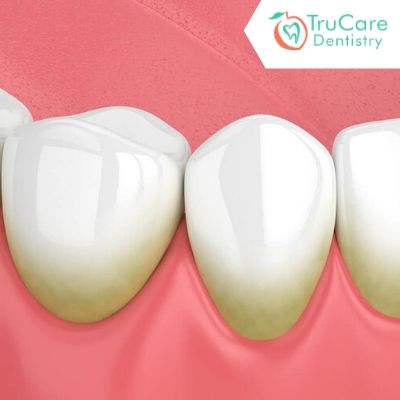
Tartar is formed due to the salivary salts (calcium and others) present in the saliva. It is often found in patients who fail to clean the soft plaque layer that accumulates on the teeth. Plaque is a sticky colorless deposit containing bacteria. If ignored for a week, the segment starts binding with salivary salts to form crystals. They eventually harden within plaque and form crusty deposits that trap stains. The resulting yellow or brown colored layer is referred to as tartar or calculus. Even a little bit of calculus can result in red, sore, or bleeding gums.
Tartar develops quickly on the inside of the lower front teeth, and the outer side of upper molars. If ignored, calculus can also cause periodontal disease. The layer has the potential to destroy the tooth enamel, trigger bad breathe, and cause tooth loss as well. Tartar can easily absorb stains, thus, results in cosmetic issues for individuals who love tea, coffee, and other highly pigmented beverages.
Some patients accumulate tartar very quickly. Individuals who have diabetes, hormonal changes, and menopause are prone to calculus.
Dentists can remove a small amount of calculus easily with the help of modern tools. The process is also a part of regular preventative dental care and is performed by dental care experts as a part of professional cleaning sessions as well.
Stop tartar by stopping plaque
A soft, sticky film on the teeth formed due to lack of brushing and flossing is plaque. It consists of bacteria that release acids. Tartar is formed when the patient ignores plaque for more than a week. The buildup can result in tender, swollen gums.
The best way to fight plaque is by limiting sugary snacks, avoiding in-between meal snacks, and regular brushing, flossing. Visiting your dentist for a six-monthly check-up and cleaning session also remains crucial.
Tartar or calculus creates a rough and stickier surface for the accumulation of more plaque, further resulting in cavities. The formation of calculus along the gum line can result in gum disease. If necessary, you can ask your dentist to apply dental sealants on the chewing surface of the teeth for avoiding decay and accumulation of bacteria that help in the formation of plaque.
Can teeth whitening procedures help in removing tartar?
Along with food items, even coffee, tea, and smoking can trigger discoloration of teeth. Teeth whitening at a dental clinic can help you in achieving a set of shiny white teeth.
Teeth whitening and cleaning are two different procedures. No matter if the dental clinic uses whitening trays or laser whitening, most of the dentists recommend cleaning before whitening to protect teeth from subsequent damage.
Trays do not fit appropriately on teeth that have a layer of tartar. Thus, the coating needs to be scrapped to make sure the tooth surface does not remain uneven. So, the pre-cleaning procedures performed by the dentist before whitening involve getting rid of plaque and tartar.
Your teeth whitening dentist will clean the food particles, remove accumulated plaque, clean tooth stains, identify and fill cavities as well. Performing these processes also helps in making sure there are no dark spots on the teeth surface.
In some cases, the results of cleaning would bring back your happier smile, even before starting the whitening procedure.
Dentists use tools like scalers, saliva ejector tube, air/water syringe, and dental polisher, during check-up and cleaning session. The cleaning procedure performed before whitening is safe, painless, and the most effective way of ensuring you get a superb white smile.
Ways for preventing calculus buildup
- Effective cleaning, dental flossing daily can help in preventing the formation of plaque.
- ADA- approved toothbrushes designed for removing plaque and tartar can do the trick.
- Using one of the electric toothbrushes with oscillating head can also prove to be an effective way for plaque removal. It is the best tool for individuals with disabilities and dexterity problems.
- Rinsing your mouth with a fluoride mouthwash can help.
- For people who wish to avoid string-floss, using a water flosser can be a good idea. The device flushes water in spaces between the teeth that are hard to reach for a toothbrush or string-floss.
- Visiting your dentist and getting your teeth cleaned by a hygienist after every six months remains crucial.
Patients often end up damaging the tooth enamel while trying to clean the hard tartar with the toothbrush. Remember, the toothbrush cannot remove the tartar layer. Only a dentist or hygienist can remove the tartar layer by performing appropriate cleaning procedures.
Dentists perform a process called scaling for removing calculus formed on teeth as well as the gumline. No matter if the layer is below or above the gum line, it is recommended to choose an experienced dentist for the removal of tartar. If you are searching for the most reputed dental office in Roswell (GA), you should consider getting in touch with TruCare Dentistry.
